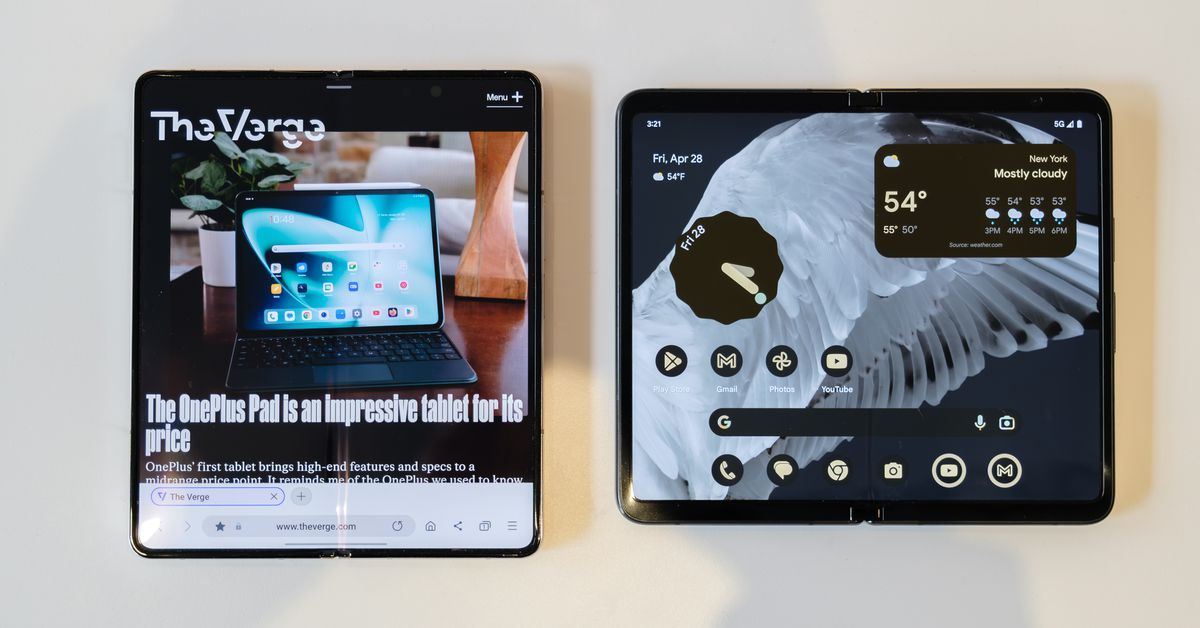Google Pixel Fold vs. Samsung Galaxy Z Fold 4: specs comparison
Here, we’re pitting the two folding ultra-flagships up against one another to compare their specs and features on paper. While Samsung is on its fourth iteration of the Galaxy Fold, Google will be a first-time player in the world of foldable phones when the Pixel Fold launches in late June. But can Google really even compete with a first-gen product?
Let’s see how they fare, at least on paper, until we’ve had a chance to fully review the new Pixel Fold.
Google Pixel Fold vs. Samsung Galaxy Z Fold 4: A game of inches and aspect ratios
The gap between a closed Pixel Fold is barely visible. Photo by Dan Seifert / The Verge It’s like the Galaxy Z Fold 4 has the least desirable thigh gap. Photo by Allison Johnson / The Verge
Some of the biggest things setting these Android phones apart are their sizes and proportions. The Galaxy Z Fold 4 starts out fairly tall and skinny, unfolding into an almost square-like device. The Pixel Fold, on the other hand, has a smaller outside screen that’s wider — giving it a more standard phone feel before you unfold it. Once unfolded, however, the Pixel has a wider, more squat stance.
Their internal screens are actually both 7.6-inch OLEDs, but the difference in feel and size comes down to those proportions. The 6:5 aspect ratio of the Pixel Fold affords it that wider 5.8-inch outer screen, while the Galaxy Z Fold 4’s 21.6:18 aspect ratio leads to a taller 6.2-inch cover screen. It’s almost half an inch bigger, but the Pixel Fold looks more usable on its outside, like a regular phone.
Bezels for days, yes, but aside from those weird corners, the Pixel Fold’s outer screen looks somewhat conventional. Photo by Dan Seifert / The Verge As our own David Pierce said on a recent episode of The Vergecast, “When you close the Galaxy Fold, it basically turns into a TV remote — it’s like 11 feet long.” Photo by Allison Johnson / The Verge
Staying in the size department for a moment, the Galaxy Z Fold 4 is slightly thinner — but not when folded. The Pixel Fold has a very narrow gap between its folded halves, which, at least in pictures, helps it look quite handsome (for a Pixel device).
Now, as for other key specs, two of the biggest deciding factors for most people buying a new phone are the cameras and battery life. While camera performance is something that goes well beyond specs, there’s no denying that the Galaxy Z Fold 4 has a much larger main sensor — which usually means better low-light performance. But, in terms of battery life, the Pixel Fold has a larger, 4,821mAh capacity. Of course, if software optimization isn’t up to snuff, it may not be as big of an advantage as it seems.
As for other features, the two phones differ greatly in the processor department; the Galaxy uses a Qualcomm Snapdragon 8 Plus Gen 1, while the Pixel Fold uses Google’s own Tensor G2 (the same chip as the Pixel 7 generation). Another stark contrast between the two is the Galaxy Z Fold 4’s stylus support, as it’s compatible with the Samsung S-Pen Fold Edition (an additional $50 purchase) while the Pixel Fold is for your fingers only. Differences aside, the phones have a lot of parity when it comes to ports, fingerprint sensor location (both are in the power button), water resistance, RAM, and starting storage capacity.
Here’s a deeper look at all the specs of the two devices side by side:
Google Pixel Fold vs Samsung Galaxy Z Fold 4 spec comparison Specification Google Pixel Fold Samsung Galaxy Z Fold 4 OS Android 13 Updated to Android 13 Main screen size 7.6-inch OLED 7.6-inch OLED Main screen resolution 2208 x 1840, 380ppi 2176 x 1812, 374ppi Main screen aspect ratio 6:5 21.6:18 Cover screen size 5.8-inch OLED 6.2-inch OLED Cover screen resolution 2092 x 1080, 408ppi 2316 x 904, 402ppi Cover screen aspect ratio 17.4:9 23.1:9 Max refresh rate 120Hz 120Hz Dimensions (open) 139.7 x 158.7 x 6.8mm 155.1 x 130.1 x 6.3mm Dimensions (closed) 139.7 x 79.5 x 12.1mm 155.1 x 67.1 x 15.8 (hinge) - 14.2 (unfolding side) mm Weight 283g 263g Battery capacity 4,821mAh 4,400mAh Processor Google Tensor G2 Qualcomm Snapdragon 8 Plus Gen 1 RAM 12GB 12GB Storage 256GB, 512GB 256GB, 512GB, 1TB Ports USB-C charging port USB-C charging port Rear camera 48MP, f/1.7, 0.8μm (main), 10.8MP, f/2.2, 1.25μm (ultrawide), 10.8MP, f/3.05, 1.22μm, 5x (telephoto) 50MP, f/1.8, 2.0μm (main), 12MP f/2.2, 1.12μm (ultrawide), 10MP, f/2.4, 1.0μm, 3x (telephoto) Front camera 9.5MP, f/2.2, 1.22μm (cover), 8MP, f/2, 1.22μm (main) 10MP, f/2.2, 1.22μm (cover), 4MP, f1/8, 2.0μm (main) Video HDR, 4K video recording at 30fps and 60fps, 1080p video recording at 30fps and 60fps, slow-motion video up to 240fps, 4K timelapse with stabilization, astrophotography timelapse HDR, 8K video recording at 24fps, 1080p and 4K video recording at 30fps and 60fps, slow-motion 1080p video support at 240fps, super slow-mo 720p video support at 960fps, hyperlapse 4K video support at 30fps Biometrics Fingerprint scanner in power button, Face Unlock Fingerprint scanner in power button Water and dust protection IPX8 rating IPX8 rating 5G mmWave and sub-6GHz mmWave and sub-6GHz Wireless Wi-Fi 6E, Bluetooth 5.2 Wi-Fi 6, Bluetooth 5.2 Wireless charging? Yes Yes Stylus support? No Yes Color options Obsidian, porcelain Gray-green, phantom black, beige, and burgundy (Samsung.com exclusive) Availability June Now Starting price $1,799.99 $1,799.99
What do you think? Does the Pixel Fold look like a promising first attempt from Google? Are you looking to plunk down $1,800 on it, or would you rather get a Galaxy Z Fold 4 on sale? Samsung’s flagship foldable has seen its share of discounts, though there have arguably been no deals more consistent and deep than what we’ve seen on the Pixel 7 generation. Maybe the Pixel Fold will follow suit. Let us know what you think in the comments.
Source: The Verge


